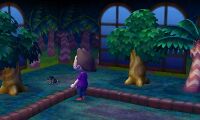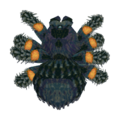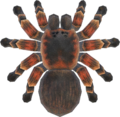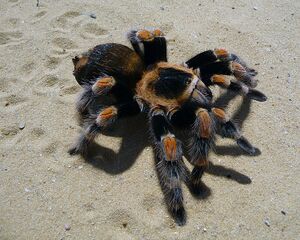Tarantula
| ||||||||
 | ||||||||
| Real-world info | ||||||||
|---|---|---|---|---|---|---|---|---|
| Name: Brachypelma smithi Family: Theraphosidae | ||||||||
| Main appearances | ||||||||
|
| ||||||||
| Other appearances | ||||||||
Names in other languages
タランチュラ
狼蛛 Tarentule Tarántula Tarantola Паук-птицеед
타란툴라 狼蛛 Tarentule Tarántula Vogelspinne Vogelspin | ||||||||
The tarantula[nb 1] is a rare insect in the Animal Crossing series. It is worth 8,000 Bells. They are found on the ground at night, and they can be difficult to catch, similar to the scorpion and wasp, as well as harmful—however, they do not attack the player unless they are carrying a net, and, unlike the wasp, the tarantula does not leave a mark. If startled by rapid movement (whilst holding the net), in the same fashion as the scorpion, it will attack (presumably bite) the player, causing the player to be momentarily stunned before fainting, which then leads to the player waking up in front of their house, or the dock next to Wilbur or Kapp'n on a Mystery Island or boat tour island respectively. If the player is not carrying the net whilst a quick movement is made near the tarantula, like many other bugs in the game, it will move away from the player, and can disappear if chased for a while.
In Animal Crossing: New Horizons, if a villager is near a tarantula, they will stop what they were doing, display the shocked reaction, then stare at the tarantula using the intense reaction until it despawns. If the player successfully catches one, the villager will display a sigh of relief using the sighing reaction, then return to what they were doing. The same applies to the scorpion. Unlike in past games, tarantulas are active from late fall to mid spring, rotating with the scorpion.
Catch details[edit]
In Wild World[edit]
| Description | Their poison isn't potent enough to be lethal, but their belly hair causes itchiness. |
|---|---|
| Time of year | Jun – Aug |
| Time of day | 7 PM – 4 AM |
| Peak times | N/A |
| Location | On the ground |
| Bug size | 65 mm |
| Rarity | Rare |
| Selling price | |
| Furniture size |
In City Folk[edit]
| Description | The belly hairs these use to fire poison cause more itchiness than the poison itself. |
|---|---|
| Time of year | Jun – Aug |
| Time of day | 7 PM – 4 AM |
| Peak times | N/A |
| Location | On the ground |
| Bug size | 65 mm |
| Rarity | Rare |
| Selling price | |
| Furniture size |
In New Leaf[edit]
| Time of year | Jun – Aug |
|---|---|
| Time of day | 7 PM – 4 AM |
| Peak times | N/A |
| Location | On the ground |
| Size | 83 mm |
| Rarity | Rare |
| Selling price | |
| Furniture size |
In New Horizons[edit]
In Animal Crossing: New Horizons, the tarantula is a lucky item during winter, meaning it gives a 777-point Happy Home Academy bonus when placed in the player's house.
| Time of year | North: Nov – Apr South: May – Oct |
|---|---|
| Time of day | 7 PM – 4 AM |
| Location | On the ground |
| Weather | Any weather |
| Spawn requirement | Appears from the start of the game |
| Selling prices | |
| Furniture size |
Donating to the museum[edit]
As with all insects in the Animal Crossing series, the tarantula can be donated to the museum, followed by a small talk by Blathers, the curator.
In Wild World[edit]
The tarantula can be found in the second room of the bug exhibit, in the area where the dung beetle and pill bug are displayed.
In City Folk[edit]
It can be found in the first enclosure on the middle terrace, which holds the scorpion, centipede, flea, and fly, to name a few.
The scorpion and tarantula can be seen battling with each other when both have been donated. The scorpion can be seen shaking its stinger at the Tarantula, which makes a rattling noise. The tarantula can be heard making a hissing-type noise, which might be associated with the insect's defense mechanism of scratching hairs at enemies. They will circle each other, and eventually both jump into the air and collide, then begin their battle again. If the scorpion is absent, the tarantula will watch the player.
In New Leaf[edit]

Rather than a small talk by Blathers, information is provided on the tarantula's enclosure.
Before the scorpion is donated, the Tarantula walks around in its small part of the enclosure. When the player walks near the Tarantula, it will stop in its tracks and stare at the player, turning as the player walks. When the player walks away for long enough, the tarantula will continue walking. If a scorpion is donated the tarantula and scorpion will jump in the air and slam into each other.
In New Horizons[edit]
The tarantula can be found in the laboratory section of the bug exhibit, contained within a forest display case.
Gallery[edit]
Real-world information[edit]
It is unknown what type of tarantula appears in the Animal Crossing games. There are different types of tarantula: ground hunters, tree hunters, as well as venomous and nonvenomous ones. Although a tarantula has eyes, its keenest sense is touch. It feels vibrations in the ground and determines the location of its prey through them. They are exothermic, but under a thermal image, the abdomen appears the brighter than the rest of its body (indicating warmth).
The tarantula in the Animal Crossing series resembles the Mexican redknee tarantula (Brachypelma smithi). These terrestrial tarantulas of the west side of Sierra Madre Occidental and Sierra Madre del Sur are popular among enthusiasts. The females can live to be 30 years while the males lead a much shorter 5 years or so. The male has a comparable size to the female, but has a smaller body with longer legs. The tarantula must undergo occasional molting to grow. The Mexican redknee tarantula is docile, unlike the tarantula in Animal Crossing, and it is only slightly venomous.
Names in other languages[edit]
| タランチュラ taranchura |
Tarantula (Derived from English) | |
| 타란툴라 tarantulla |
Tarantula (Derived from English) | |
| 狼蛛 lángzhū |
Wolf spider | |
| Паук-птицеед Pauk-ptitseyed |
Tarantula (lit. "birdeater spider") | |
| Vogelspin | Tarantula (lit. "bird spider") | |
| Vogelspinne | Tarantula (lit. "bird spider") | |
| Tarántula | Tarantula | |
| Tarentule | Tarantula | |
| Tarantola | Tarantula | |
Notes[edit]
| Bugs | ||||||||||||||||||||||||||
|---|---|---|---|---|---|---|---|---|---|---|---|---|---|---|---|---|---|---|---|---|---|---|---|---|---|---|
| ||||||||||||||||||||||||||







